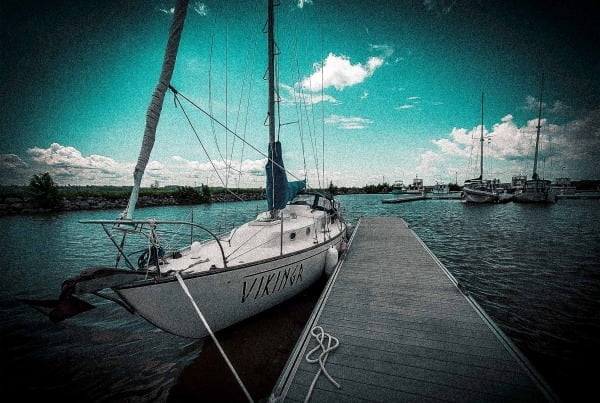Obtain a license or register my boat? What are the advantages of one over the other? How do you change the name of our boat?
In Canada, the Canadian Vessel Registration Registry is responsible for managing registrations and the Office of Boating Safety manages pleasure craft licenses. The services offered are: the registration of a commercial vessel or a pleasure craft, the transfer of an ownership, the notification of a change, the addition or cancellation of a lien (mortgage) on a boat.
Good news, all of this is easily done online on the Transport Canada website, under the marine transport, permits and vessel registration section.
That said, you can also download all forms in PDF and print them on your computer to complete them for later. Useful when more than one person needs to sign the forms, for example.
Okay so, in the end
do I chose a license or
do I register my boat?
Existential question, do you really need it?
First of all, it might be possible that your boat does not need either a license or registration! Indeed, if your boat (called a vessel on the Transport Canada site) does not need:
- a marine mortgage to be registered with Transport Canada
- a unique registered name (like VIKINGR)
- or if you do not plan to travel abroad and be recognized internationally as a registered vessel
- and that in addition, it has no engine or one less than 7.5 kW (10 HP), (i.e. human-powered such as a canoe or kayak), that it is a watercraft pleasure craft or a small sailing vessel less than 8.5 meters,
Then you don’t have to have a license or registration. However, you can do it all the same for safety reasons.
So, license or registration?
According to Canadian law, if the use of your boat is commercial, you are required to register it.
You only need a license if your boat does not have a marine mortgage that has to be registered with Transport Canada, you do not want a unique vessel name to be registered, and you will not be traveling internationally in which case your vessel has to be registered or, finally, that your engine is smaller than 10HP and that you are not engaging in commercial activities.
In all other cases, you must obtain a registration. Either in the register for small vessels if your boat has a gross tonnage of less than 15 tons. Gross tonnage is a method of measuring the carrying capacity of a vessel.
The Transport Canada site allows you to complete a small anonymous form to find out if we need a permit or registration. The answer is displayed immediately and directly on the page. This is what I did to make sure I was making the right choice. You should do the same!
How to avoid delays?
All requests are handled individually by a Transport Canada specialist. To avoid delays, be sure to fill out all forms and sign them. In fact, an incomplete or unsigned form cannot be accepted. So, you will find yourself back at the bottom of the pile …!
It is also faster if you send your form outside of busy times, ie from June to September. So sending your registration forms in November will result in them processed faster.
Make sure you check the spelling … and that the names you mention on the form (you will have three choices to provide) are the ones you want to use.
Change the name of your boat in 5 steps
No matter what name you want to give to your boat, there are a few simple rules to follow to make sure it gets accepted. Of course, the name must still be available …!
On its website, Transport Canada suggests several considerations to remember about the names of the boats. It reads, among other things: “For safety reasons, each registered vessel must have a unique name. This should be the case when the name is said aloud, especially in a radio transmission. For example, “Easy Living” and “EZ Livin” sound too similar when said out loud for both names to be approved ”. That makes a lot of sense.
Here are the steps I took to change the name of my boat (btw, if you want to know why I changed the name of my boat, you can read my article on this subject: Caribou D. → VIKINGR )
1- Check the availability of the desired name
It would be good to start by researching the vessel registry to make sure that the name you want is not already in use. You can do a boat name search on the Transport Canada website.
2- Make sure you follow the guidelines set out by Transport Canada
The name you want should be unique, even when said out loud, as I mentioned in the previous paragraph: for example, “Easy Living” and “EZ Livin”. You cannot use a registered trademark or a prohibited mark. Obviously, it should not be confused with a sign of distress. It should also not include vessel acronyms such as “SV” (Sailing Vessel) for sailing vessel or “FV” (Fishing Vessel) for fishing vessel. It may, however, include an item such as “the”, “the”, “la”, “l ‘”. However, Transport Canada does not consider these when a name is approved (for example, the name “LE GOLDEN FISH ”is the same name as“ GOLDEN FISH ”); It is precisely this rule that I had not retained that played a little trick on me when I made my first request for a name change.
If you also want to use the name of a city in Canada or a Canadian personality, you will need to provide a letter of authorization.
3 – Complete form 13
Go to this page to fill out form 13. You can fill it out directly from your computer or print it out and fill it out by hand later to then mail, email or fax it.
Here are the different options available to send your completed form and payment. I strongly suggest that you send it by email and make your payment online, it’s much faster.
You can send your documents by mail, fax or email to:
Transport Canada
Vessel registration (AMSED)
330 Sparks Street
Ottawa, Ontario K1A 0N8
Fax: 1-833-983-1377
Email: vr-ib@tc.gc.ca
Payment options
By phone (with a credit card)
By check or money order payable to the “Receiver General for Canada”
4 – Make the payment
For all name changes, there is a related charge. At the time of writing this article, costs are $ 250. You can therefore send your payment by mail, fax or email. Once again, I suggest that you make your payment online. To do this, you must go to this page: https://wwwapps.tc.gc.ca/Comm/5/MVR/fra/registre-canadien-batiment/commander
5 – Delete the old name and add the new one
You can now delete your old boat name and have the new name registered. For my part, I will be using a vinyl sticker made specifically for this. Which still allows a little more artistic freedom …
Haaa yes .. according to superstition and maritime tradition, you should not change the name of a boat so as not to attract the wrath of Neptune. Or, if you want to do it, you have to cut the macoui. The macoui is attached to the name of the boat, it is the great serpent that constantly follows the boat. You need to cut the wake so the serpent will follow the boat under its new name If you want to know more about how to cut macoui, go read my article on renaming my boat from Caribou D. to VIKINGR.
There you go, I hope you enjoyed this article! If you find errors or if links are no longer valid, you would be very kind to let me know!
Good luck!

Voilà! Hope you enjoyed this article ?!
- If so, feel free to share it. It helps me with Google SEO and it doesn’t cost you anything.
- Also, you can subscribe to my private list, by entering your email address and your first name, at the bottom of this page. That way, you’ll be notified when I publish a new article!
- And finally, your opinion / comment is welcome!





